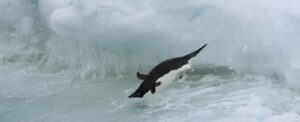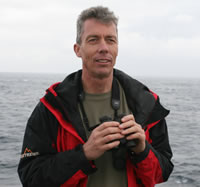By Peter Ryan, onboard scientist, expert in general ornithology, seabird-fishery interactions, evolutionary ecology, marine debris, solid waste management, biology of oceanic islands.
Leg 2, Day 6.
Finally we reached the ice, and the associated sea-ice avifauna. Altogether, five new bird species were seen. The early risers were rewarded with large numbers of Antarctic and Snow Petrels, and lesser numbers of Southern Fulmars, as we passed through the marginal ice zone where the sea ice meets the open ocean (11.8 birds per km for the first 2 hours). The density of birds dropped as we progressed south towards the continent (5.8 birds per km for the next 4 hours), and especially in the open waters of the polynia (0.7 birds per km for the next four hours), only increasing slightly as we approached the sea-ice around the glacier (1.7 birds per km for the final 2 hours). Adelie Penguins were common throughout, but only one Emperor Penguin was seen, as we broke through the final barrier of sea ice. This was also the only place we saw any Weddell Seals; those farther north were the more abundant Crabeater Seals. Cetaceans were scarce, with a couple of Antarctic Minke Whales among the sea ice early on, and another probable Minke near the glacier in the afternoon.
| Adelie Penguin | 262 | Snow Petrel | 205 |
| Antarctic Petrel | 199 | Antarctic Fulmar | 44 |
| Arctic Tern | 16 | Southern Giant Petrel | 13 |
| Mottled Petrel | 12 | Wilson’s Storm Petrel | 12 |
| Cape (Pintado) Petrel | 5 | South Polar Skua | 3 |
| Emperor Penguin | 1 |
No kelp or litter was seen, but a bucket sample collected in the polynia off Mertz still contained what appear to be synthetic fibres. Although the sample was collected from the bow while the ship was underway it would be nice to collect a sample from a zodiak to rule out the possibility of a ship effect.

